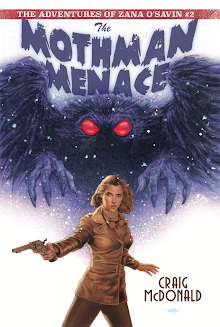The conflict between literary vs. genre fiction is an old and storied war with no good end in sight.
My novels featuring author Hector Lassiter are pitched at the
center of that perhaps unwinnable cultural siege.
Hector, a consummate survivor who comes to be known as “the
last man standing of the Lost Generation” went to 1920s Paris dreaming of becoming
a literary writer. He emerged a crime novelist and sometimes screenwriter compelled
to apologize for his work to his literary friends who people my novels: Ernest
Hemingway, John Dos Passos, William Carlos Williams…Gertrude Stein.
 |
| Alice B. Toklas & Gertrude Stein |
My novel One True
Sentence, is the one in which Stein and Hemingway cast their longest shadows.
OTS is a re-imagination of Ernest
Hemingway’s 1920s Paris memoir A Moveable
Feast as a historical thriller. The murders of literary magazine publishers
plague the Left Bank; Stein gathers the city’s foremost mystery writers to catch
the killer.
Stein, the Modernist grand dame of 1920s Paris — the woman
who coined the phrase “Lost Generation” and an avant-garde experimenter in prose whose writings remain opaque or even
unreadable to the most patient of readers — was, in fact, an avid fan of
mystery fiction. Stein affectionately dubbed favorite crime fiction authors her
“mystifiers.” She contended the mystery novel was “the only really modern novel form.”
When a young Hemingway, newly arrived in Paris and bearing a
letter of introduction from novelist Sherwood Anderson first visited Stein in
her salon, he left with many literary recommendations, including Marie Belloc Lowndes’ Jack the Ripper novel, The
Lodger.
 |
| Marie Belloc Lowndes |
Stein’s preface to that reading recommendation was charged: “You should,” she said, “only
read what is truly good or what is frankly bad.” Lowndes’ writing, Stein assured,
was “marvelous in its own way.”
Hemingway agreed: “I read all the Mrs. Belloc Lowndes that
there was… I never found anything as good for that empty time of day or night
until the first fine Simenon books came out.” For his part, Hemingway remained
a crime fiction fan, reading Dashiell Hammett, Raymond Chandler and Ian Fleming
when they were each new and still largely under the reading public’s radar.
Hemingway’s Key West-based To Have and Have Not, for much of its early going, reads like a hardboiled crime novel.
 |
| Scene from first film adaptation of THE LODGER. |
Hemingway’s Key West-based To Have and Have Not, for much of its early going, reads like a hardboiled crime novel.
Consistent with her insistence upon always having the last
word, consider Stein’s rather mysterious summation of the value of the mystery
novel:
“By having the man dead to begin with the hero is dead to begin with and
so you have so to speak got rid of the event before the book begins… The only
person of any importance is dead.”
That “important” dead person, to Stein’s mind, was the traditional
literary hero. Detectives, therefore, were the survivors, and as such, what
Stein termed a new kind of “literary hero.”
NEXT: The first of two prose pieces, in Hector's own words...
NEXT: The first of two prose pieces, in Hector's own words...







































No comments:
Post a Comment